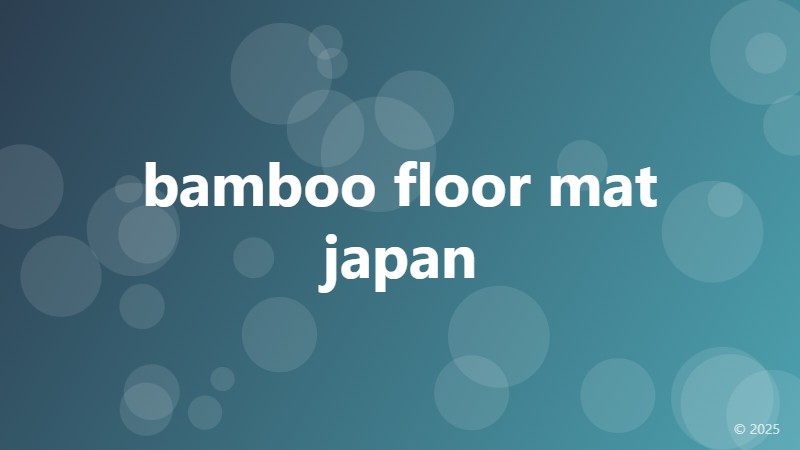bamboo floor mat japan

The Art of Traditional Japanese Flooring: Bamboo Floor Mats
When it comes to traditional Japanese flooring, bamboo floor mats are an iconic and timeless choice. For centuries, the Japanese have revered bamboo for its durability, sustainability, and aesthetic appeal. In Japan, bamboo floor mats are not just a practical flooring solution, but an integral part of the country's cultural heritage.
A Brief History of Bamboo in Japan
Bamboo has been an integral part of Japanese culture for thousands of years. The plant was first introduced to Japan from China around 300 BCE and quickly became an essential material for building, crafting, and even food. In traditional Japanese architecture, bamboo was used extensively for roofing, walls, and flooring due to its strength, flexibility, and resistance to pests and decay.
The Unique Properties of Bamboo Floor Mats
Bamboo floor mats are renowned for their unique properties, which set them apart from other types of flooring. One of the most significant advantages of bamboo floor mats is their eco-friendliness. Bamboo is a highly renewable resource that can be harvested in as little as three to five years, compared to traditional wood which can take decades to mature. Additionally, bamboo absorbs more carbon dioxide and produces more oxygen than many other plants, making it an environmentally sustainable choice.
Bamboo floor mats are also incredibly durable and resistant to wear and tear. They can withstand heavy foot traffic and are less prone to scratches and dents than traditional wood flooring. Moreover, bamboo floor mats are naturally resistant to moisture, making them an ideal choice for kitchens, bathrooms, and other areas prone to humidity.
Traditional Japanese Designs and Patterns
Bamboo floor mats in Japan often feature traditional designs and patterns that reflect the country's rich cultural heritage. One of the most iconic designs is the "tatami" pattern, which consists of rectangular mats with a woven grass or reed core. Tatami mats are often used in traditional Japanese homes and are typically adorned with intricate designs and patterns.
Other popular designs include the "shibori" pattern, which features a tie-dye effect, and the "kiri" pattern, which showcases a geometric design. These traditional designs not only add aesthetic appeal to a room but also tell a story about Japan's rich cultural history.
Modern Applications of Bamboo Floor Mats in Japan
In modern Japan, bamboo floor mats are not just limited to traditional homes and cultural institutions. Many contemporary architects and interior designers are incorporating bamboo floor mats into their designs due to their sustainability, durability, and aesthetic appeal. From trendy cafes to luxury hotels, bamboo floor mats are becoming an increasingly popular choice for businesses and homeowners alike.
In conclusion, bamboo floor mats are an integral part of Japan's cultural heritage and a testament to the country's commitment to sustainability and eco-friendliness. Whether you're looking to add a touch of traditional Japanese flair to your home or seeking a durable and eco-friendly flooring solution, bamboo floor mats are an excellent choice.